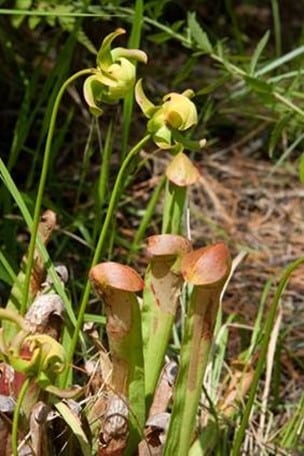The hooded pitcher plant (Sarrecina minor), Photo by Carole Adams
There are more species of carnivorous (insect eating) plants in Florida wetlands than anywhere else in the country. There are six species of native pitcher plants with hollow stems that serve as passive insect traps. In this area, the common pitcher plant habitat is at least seasonally wet, level land with acidic soil conditions. Typical natural pitcher plants habitats are wet savannahs, cypress domes and flatwoods. Man-made sites can include ditches and shallow borrow pits.
The common pitcher plant in Northeast Florida counties is the hooded pitcher plant (Sarrecina minor). This species ranges from North Carolina south into North Florida. Like most of the group, it has hollow tubular leaves with a hood at the top that secretes nectar to attract prey.
Once insects are on the lip of the pitcher, they can slip on the waxy opening and fall into the plant. Hairs on the inside of the trap point downward, preventing insects from crawling back up. The often brightly colored or patterned hood appears like windows allowing light to enter. But to the dismay of the victim, the windows are closed. It also has a curled lip to help control the amount of rainwater entering the tube. These plants also secrete digestive enzymes and fluids in the pitcher so that insects are digested and absorbed after they drown or die of exhaustion. The result is a nitrogen-rich “liquid fertilizer” available to the plant.

Illustration by William Bartram. Bartram, in his book Travels, documented and sketched the hooded pitcher plant during his East Florida territory and St. Johns River explorations in 1774.
In natural habitat systems, pitcher plants can be exposed to fairly frequent lighting strike fires, particularly in the growing season. The frequent fire maintains the open features of the wetland and ensures a sunny environment. The exclusion of fire from these natural wetland ecosystems communities reduces the pitcher plant optimum habitat suitability.
The hooded pitcher plant produces yellow flowers with no noticeable scent, beginning in early summer. The downward turned petals are large, dangling and are very thin. They flutter in the slightest breeze. This movement signals bees and other pollinators to the wetlands that nectar is available.

Pitcher Plants in Bloom, Photo by Carole Adams
Some man-made drainage alterations, such as canals, deep ditches, dams and even roadways, have adversely impacted pitcher plant habitat by changing the natural hydrology. One exotic animal, the feral pig, can significantly disturb the soil, often posing a threat to pitcher plant habitat.
For hundreds of years people have been fascinated by these amazing plants. Unfortunately, pitcher plant habitat in Florida is at risk primarily from development, fire suppression and drainage alterations, such as ditching. On the bright side, the need for conservation of these species in the wild is becoming more well-known and the public has expressed concern about protecting these unusual plants. In our state, as with much of its range, the hooded pitcher plant is listed as threatened and is highly protected.
